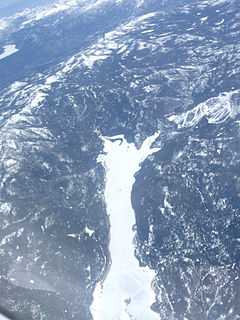Huntington Lake
| Huntington Lake | |
|---|---|
 | |
| Location | Fresno County, California |
| Coordinates | 37°14′9.96″N 119°10′44.4″W / 37.2361000°N 119.179000°WCoordinates: 37°14′9.96″N 119°10′44.4″W / 37.2361000°N 119.179000°W |
| Type | Reservoir |
| Primary inflows | Big Creek |
| Primary outflows | Big Creek |
| Basin countries | United States |
| Surface area | 1,441 acres (583 ha) |
| Surface elevation | 2,120 m (6,955 ft)[1] |
Huntington Lake is a reservoir in Fresno County, California on Big Creek, located in the Sierra Nevada at an elevation of 2,120 meters (6955 ft). Several smaller streams also flow into the lake and it receives additional water from the underground tunnels of Southern California Edison's Big Creek hydroelectric project. Water from the lake flows into Big Creek, but some is diverted by underground tunnels to the Eastwood Powerhouse, which discharges into Shaver Lake.
History
Huntington Lake was constructed in 1912 as a part of the enormous Big Creek Hydroelectric Project envisioned by John S. Eastwood to provide power for a growing California. The lake was named for Henry Edwards Huntington, the railroad magnate who financed the earliest work to develop the Big Creek project which includes a system of lakes, tunnels, steel penstocks and power houses.
Four dams form the lake, which has a capacity of 88,834 acre feet (109,575,000 m3) and a surface area of 1,441 acres (5.83 km2). There were originally three dams, completed in 1913, but a fourth dam, completed in 1919, was built to increase the lake's capacity. The other three dams were raised and covered with concrete. State Route 168 passes along the east shore of the lake where China Peak, a ski resort, is located.
On December 6, 1943, a B-24 bomber with six men aboard crashed into Huntington Lake.[2] The crew had taken off from nearby Hammer Field in Fresno, California to search for a second B-24 which had disappeared a day earlier during a night training flight. Two members of the original eight man crew, a radio operator and the co-pilot, bailed out of the troubled plane and survived. Some have speculated that the pilot may have mistaken the lake for a sierra meadow and tried to make an emergency landing during a snow storm. The wreckage of the plane, and the remains of its crew were discovered by a survey team in August 1955, when the lake had been drained for dam repairs.[2] The original B-24 they had been searching for was discovered in July 1960 in Hester Lake, a small body of water in a remote area not far from Huntington. Neither plane has been recovered.[citation needed]
Sailing


Huntington Lake hosts an annual sailing event, the High Sierra Regatta, which is organized by the Fresno Yacht Club.[3] 2013 represented the 60th year of racing on Huntington Lake. The regatta spans two weekends during July.


The first weekend is made up of centerboard-class boats, while the second features mostly larger keel boats. Up to 150 boats sail each weekend. The number of boats each weekend is limited by the U.S. Forest Service, and Regatta entry is conducted on a first-come-first-serve basis.
The High Sierra Regatta attracts Olympic gold medalists, and national champions.[citation needed] The consistent winds and beautiful scenery are popular with sailors from all over the country.[citation needed]
See also
References
- ↑ "Huntington Lake". Geographic Names Information System, U.S. Geological Survey.
- ↑ 2.0 2.1 Zamora, Eric Paul. "World War II B-24 bomber crash at Huntington Lake marks 70 years". The Fresno Bee. Retrieved 14 October 2013.
- ↑ http://www.fresnoyachtclub.org/hsrdetails.htm
External links
- Sierra National Forest - Huntington Lake
- Huntington Lake Big Creek Historical Conservancy
- California Dams Database